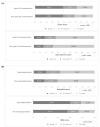Differing Nutrient Intake and Dietary Patterns According to the Presence of Hyper-Low-Density Lipoprotein Cholesterolemia or Hypertriglyceridemia
- PMID: 34578886
- PMCID: PMC8469560
- DOI: 10.3390/nu13093008
Differing Nutrient Intake and Dietary Patterns According to the Presence of Hyper-Low-Density Lipoprotein Cholesterolemia or Hypertriglyceridemia
Abstract
Dietary choices may have differing effects on low-density lipoprotein cholesterol or triglyceride levels. The aim of this study was to investigate daily nutrient intake and dietary patterns of individuals with hyper-low-density lipoprotein cholesterolemia (hLDL) and hypertriglyceridemia (hTG) in a large Korean population-based study using propensity score (PS) matching. This study used data from the Korea National Health and Nutrition Examination Survey. Propensity score values for the predicted probability of patients with hLDL or hTG were estimated using logistic regression analysis, with age, sex, body mass index, alcohol consumption, smoking status, physical activity status, hypertension, and diabetes. After PS matching, intake of carbohydrates (%) was significantly lower (p = 0.021), and intake of fats (%) and saturated fatty acids (%) was significantly higher in the hLDL group than in the non-hLDL group (p = 0.025 and p = 0.013, respectively). The percentage of individuals with a high score for the Korean Healthy Eating Index (KHEI) "whole grains" or "saturated fatty acids" components was higher in the non-hLDL group than in the hLDL group (p < 0.05 for both). Dietary sodium/potassium ratio was significantly higher in the hTG than in the non-hTG (p = 0.049). Our results suggest that individualized dietary information and counseling require consideration of a person's specific lipid levels.
Keywords: Korean Health Eating Index; low-density lipoprotein cholesterol; nutrition; triglyceride.
Conflict of interest statement
The authors declare no conflict of interest.
Figures


Similar articles
-
Dietary Patterns and the Risk of Dyslipidemia in Korean Adults: A Prospective Cohort Study Based on the Health Examinees (HEXA) Study.J Acad Nutr Diet. 2021 Jul;121(7):1242-1257.e2. doi: 10.1016/j.jand.2020.08.090. Epub 2020 Nov 3. J Acad Nutr Diet. 2021. PMID: 33158796
-
Association between Dietary Pattern and Incidence of Cholesterolemia in Korean Adults: The Korean Genome and Epidemiology Study.Nutrients. 2018 Jan 9;10(1):53. doi: 10.3390/nu10010053. Nutrients. 2018. PMID: 29315217 Free PMC article.
-
Association of Dietary Fatty Acid Consumption Patterns with Risk of Hyper-LDL Cholesterolemiain Korean Adults.Nutrients. 2020 May 14;12(5):1412. doi: 10.3390/nu12051412. Nutrients. 2020. PMID: 32422908 Free PMC article.
-
Serum low-density lipoprotein cholesterol response to modification of saturated fat intake: recent insights.Curr Opin Lipidol. 1997 Dec;8(6):332-6. doi: 10.1097/00041433-199712000-00002. Curr Opin Lipidol. 1997. PMID: 9412772 Review.
-
Nutrition therapy for dyslipidemia.Curr Diab Rep. 2003 Oct;3(5):397-403. doi: 10.1007/s11892-003-0084-z. Curr Diab Rep. 2003. PMID: 12975030 Review.
Cited by
-
Association between dietary calcium intake and severe abdominal aorta calcification among American adults: a cross-sectional analysis of the National Health and Nutrition Examination Survey.Ther Adv Cardiovasc Dis. 2024 Jan-Dec;18:17539447241232774. doi: 10.1177/17539447241232774. Ther Adv Cardiovasc Dis. 2024. PMID: 38415471 Free PMC article.
-
Association between dietary zinc intake and Helicobacter pylori seropositivity in US adults: National Health and Nutrition Examination Survey.Front Nutr. 2023 Sep 21;10:1243908. doi: 10.3389/fnut.2023.1243908. eCollection 2023. Front Nutr. 2023. PMID: 37810930 Free PMC article.
References
-
- World Health Organization . The Global Burden of Disease: 2004 Update. World Health Organization; Geneva, Switzerland: 2008.
-
- National Center for Health Statistics National Center for Health Statistics; 2021. [(accessed on 9 June 2021)]; Available online: https://www.cdc.gov/nchs.
MeSH terms
Substances
Grants and funding
LinkOut - more resources
Full Text Sources
Medical

